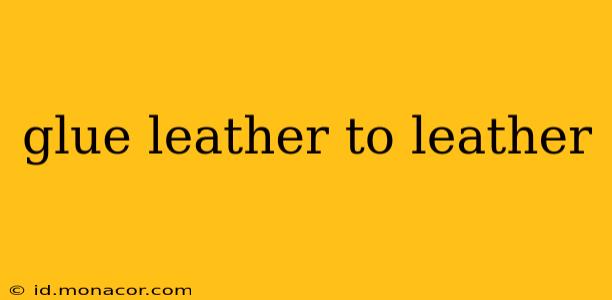Gluing leather to leather might seem straightforward, but achieving a strong, lasting bond requires careful selection of adhesive and precise application techniques. This comprehensive guide explores the best glues for the job, preparation methods, and crucial tips for success, ensuring your leather projects are durable and professional-looking.
What is the Best Glue for Leather to Leather?
The ideal glue for bonding leather depends on the type of leather, the project's intended use, and your desired level of flexibility. Several strong contenders stand out:
-
Contact Cement: This is often the preferred choice for strong, permanent bonds, particularly for heavier leathers and projects requiring high durability. Contact cement requires both surfaces to be coated and allowed to dry slightly before pressing together, creating a very strong bond. It's crucial to follow the manufacturer's instructions precisely.
-
Shoemaker's Glue: Traditionally used for shoe repair, shoemaker's glue (also known as barge cement) provides a robust bond, particularly suitable for areas requiring flexibility. It requires clamping for proper adhesion.
-
Barge Cement: Often used interchangeably with shoemaker's glue, this is another strong option ideal for heavy-duty leather work. It’s known for its excellent adhesion and water-resistance.
-
Leather Glue: Specifically formulated for leather, these glues are often flexible and provide a strong bond. Read product labels carefully to ensure compatibility with your leather type.
Avoid using general-purpose wood glues or super glues, as they may not provide sufficient adhesion or flexibility for leather, leading to cracking or separation over time.
How Do I Prepare Leather for Gluing?
Proper preparation is paramount for a successful bond. Neglecting this step can drastically reduce the glue's effectiveness.
-
Clean the Surfaces: Ensure both leather pieces are thoroughly clean and free of dust, dirt, grease, or any other contaminants. Use a soft cloth and a mild cleaner or leather degreaser if necessary.
-
Roughen the Surfaces: Lightly roughen the surfaces to be glued using fine-grit sandpaper (around 220-grit). This creates a better surface for the glue to adhere to, increasing the bond strength. Be careful not to sand too aggressively, as this could damage the leather.
-
Dry Completely: Allow the leather to dry completely after cleaning and sanding before applying glue. Any residual moisture can weaken the bond.
What is the Best Way to Apply Glue to Leather?
The application method depends on the type of glue you've chosen.
-
Contact Cement: Apply a thin, even coat to both surfaces. Allow the glue to become tacky (following the manufacturer's instructions) before pressing the pieces together firmly.
-
Shoemaker's/Barge Cement: Apply a thin layer of glue to one surface and allow it to dry to a tacky consistency. Apply a second layer and then press the two surfaces firmly together, clamping them if necessary to ensure proper adhesion.
-
Leather Glue: Follow the manufacturer's instructions. Often, a thin layer is applied to one or both surfaces, depending on the product, and the pieces are pressed together immediately.
How Long Does Leather Glue Take to Dry?
Drying time varies depending on the type of glue, the thickness of the leather, and environmental conditions. Always consult the manufacturer's instructions for recommended drying times. Generally, it can range from a few hours to 24 hours or more for a complete cure. Clamping the pieces during the drying period ensures optimal adhesion.
What are Some Tips for Successful Leather Gluing?
-
Use Clamps: Clamping the glued pieces ensures a strong, even bond, especially for larger or thicker leather pieces. Use soft jaw clamps to prevent marring the leather.
-
Work in a Well-Ventilated Area: Some glues emit fumes, so it's important to work in a well-ventilated area or wear a respirator.
-
Practice on Scraps: If you're unsure about the process, practice on scrap pieces of leather first to get a feel for the glue and the technique.
By following these guidelines and choosing the appropriate glue for your project, you can achieve a strong, durable bond that will last for years. Remember always to consult the manufacturer’s instructions for your specific glue product.

